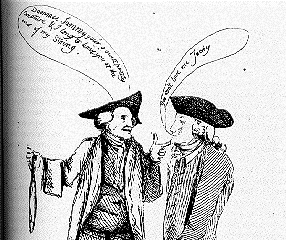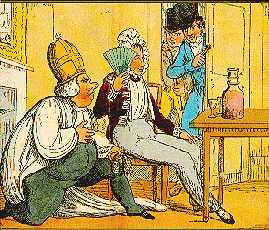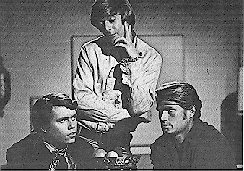 |
Pre- & Post-Stonewall Gay Male Imagery
|
Because homosexuals have generally been a despised minority in the West, at least in recent centuries, visual portrayals of them are usually fraught with cultural baggage and non-aesthetic agendas of various kinds. Mainstream Western societies have often created stereotypes that reflect their fear of the erotic, intolerance for sexual diversity, and dislike of gender role blurring.
Popular media in the US, both before Stonewall and still today, for the most part simply refused to portray gay men (or lesbians) at all. When they are presented, it has usually been as marginal characters who live in a "twilight world of misfit conduct" (Russo). These portrayals tend to alternate between traditional effeminate stereotypes used for comic effect, and lurid portrayals of homosexuals as troubled, lonely, perhaps artistic, sometimes witty (or at least waspish), often predatory and occasionally even homicidal.
More recently such images have been interspersed with attempts to portray gay men in a more positive light, promoting the "liberal" notion that gays are really "just like anyone else." Within the last year or two, a few mainstream media and advertisers have dared to brave conservative and religious fundamentalist backlash in the hope of capitalizing on what is viewed as a prosperous gay market. This new trend has resulted in a revised set of handsome, sanitized, white middle class, Madison Avenue images that seem culturally suspended among the ever-present hateful stereotypes of the past and the actual, extravagant diversity of the queer and transgender population.
Case Displays
Images from 18th & 19th Century England
Rictor Norton. Mother Clap's Molly House: The Gay Subculture in England 1700-1830. London: OBGMP, 1992.
Norton's work documents the highly developed gay male subculture in England in the 18th and early 19th centuries, which existed despite that fact that the penalty for "sodomy" during much of this period was hanging. The images below are among the illustrations included in this work.
Images of Oscar Wilde, 1892/1893
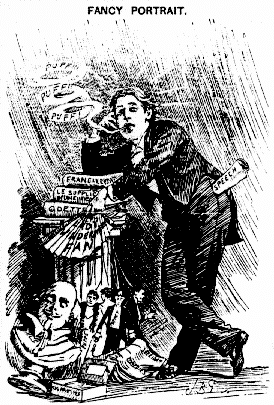 |

"Oscar Wilde," from The Sunday Chronicle (London, England), April 23 1893. |

"Noah's Head," from The Yorkshire Weekly Post (Leeds, England), April 22, 1893. |
| "Fancy Portrait" in Punch, March 5, 1892 |
Oscar Wilde, 1854-1900, called himself a "professor of aesthetic," "an apostle of pleasure," and a socialist. Perhaps the most widely caricatured figure of his time, he himself cultivated a public image of sensuous, decorative languor, emotional extravagance, and flamboyant "effeminacy," all of which were reflected in and heightened by the press and contemporary artists. After Wilde's imprisonment for sodomy, the name "Oscar" was reportedly used in the streets as an epithet to be hurled at long-haired or effeminate men, becoming the late 19th century equivalent of today's "faggot."
The detailed "Fancy Portrait" from Punch, portrays Wilde as an effete pretender to the throne of Shakespeare; the accompanying article complains about Wilde's behavior addressing the audience after a performance of Lady Windermere's Fan, during which he apparently comported himself in a way that resembled nothing so much as the performance or conceptual art of the later 20th century--a style that characterized of much of Wilde's public life.
 |
George Grossmith walks his flowery way as Reginald Bunthorne, a fleshly poet (ca. 1881) |  |
Three Aesthetic Dragoons from Patience (ca. 1881) |
Patience, a New and Original Aesthetic Opera in Two Acts, by W.S. Gilbert and Arthur Sullivan, included a satiric portrayal of Wilde and the aesthetic movement, with Wilde's affectations distributed between the two rival aesthetic poets, Bunthorne and Grosvener. Note also the photo of "three aesthetic dragoons" from the same operetta. Wilde reportedly disliked the play but appreciated the notoriety. The images are reprinted in: Robin Wilson and Frederic Lloyd. Gilbert & Sullivan: The Official D'Oyly Carte Picture History. New York: Knopf, 1984.
The Twentieth Century
Vito Russo's groundbreaking work, The Celluloid Closet: Homosexuality in the Movies, (Rev. ed. New York: Harper and Row, 1987) describes what he considers Hollywood's "consistent refusal to portray lesbians and gay men--when it portrayed them at all--as anything but one-dimensional characters, alien to the American dream." (from the introduction). The movie stills below are reproduced from Russo's book.
 |
Ernst Truex in "The Warrior's Husband" (1933) |
Ernst Truex as "Sapiens" in The Warrior's Husband (1933), a movie that takes place in "Amazonia." According to Russo, Truex plays "a progressive thinker" who enters the court of the Amazon Queen Hippolyta to the tune of "Oh, You Beautiful Doll" and sits curling his beard while the women make all the important decisions on affairs of state.
 |
Franklin Pangborn in "Only Yesterday" (1933) |
Franklin Pangborn, who spent his career playing Hollywood "sissy" roles, in a still from the movie Only Yesterday (1933). Here Pangborn and his women friends chatter about fashion while the real men of the world worry about the stock market, which has just crashed.
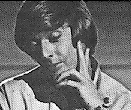 |
"The Gay Deceivers" (1969) |
A still from The Gay Deceivers (1969), a low-budget film about two straight men who would do anything to avoid being drafted (during the VietNam war). The advertising tag line read "Wear long hair, tight-fitting pants, lisp a little, put your hands on your hips, quote liberally from Oscar Wilde and Marcel Proust and ask your sergeant if he likes your mascara... You have nothing to lose but your draft card." In Steve Stewart. Gay Hollywood Film & Video Guide: Over 75 years of Male Homosexuality in the Movies. Laguna Hills, California: Companion Publications, 1993.
 |
John Cazale and Al Pacino in a still from "Dog Day Afternoon" (1975). |
| The Village People's Cruisin' (1978) |
The Village People appropriated gay male fantasy role types of the kind that had begun to capture the erotic imagination of Greenwich Village and San Francisco in the mid-Seventies. Jacques Morali, who produced the records and wrote the songs--many dripping with gay sexual innuendo--somehow managed to sell the concept to straight America without their catching on ... at least initially. The real unanswered question may be: exactly which "village" did America think these gentlemen were from?
"Cruisin'" was published in Los Angeles, by Casablanca Record & Filmworks, 1978. Songs included: "YMCA," "The Women," "I'm a Cruiser," "Hot Cop," "My Roomate [sic]," "Ups and Downs." Performers: Policeman, Victor Willis; Cowboy, Randy Jones; Construction Worker, David "Scar" Hodo; Indian, Felipe Rose; Leather Man, Glenn M. Hughes; The GI, Alexander Briley.
 |
Daddy's Roommate by Michael Willhoite (1990) |
Michael Willhoite's Daddy's Roommate (Boston: Alyson Wonderland, 1990. "For ages 2 to 6.") was possibly the first mass-market children's book to depict a child with a gay father. This book, along with Leslea Newman's Heather Has Two Mommies, was included in the controversial New York City Schools' "Rainbow Curriculum," much objected to by local opponents of diversity and multiculturalism. The images are of the "positive role model" school, showing straight-looking "Daddy" and Frank in a variety of cozy domestic scences. In this book, at least, it's all ok with Mom. Note Frank's receding hairline.
 |
Tom Hanks in "Philadelphia" (1993) |
Philadelphia,(1993), directed by Jonathan Demme and starring Tom Hanks, was a commercial hit despite being negatively received in parts of the gay community as somewhat unrealistic and dishonest. It was, however, the most exposure mainstream America has had to the image of a gay man progressively dying of AIDS. In Time, Feb. 7, 1994.
 |
Stills from IKEA's gay-oriented marketing campaign (1994). |
IKEA, a retail furniture chain, claimed they weren't really targeting the gay and lesbian community, instead describing the ad as part of a "life-stages campaign, which presents a broad swatch of America." Reprinted in John Gallagher. "IKEA's Gay Gamble," In The Advocate, May 3, 1994.
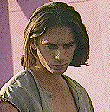 |
"The Comfort Zone" (1994) |
"The Comfort Zone," fashion advertisements. Photography by Jak McDonnell. In Genre, May 1994. The burgeoning field of slick, gay and lesbian-oriented magazines, like Genre--which largely eschew the controversial personal and phone-sex ads that long subsidized gay periodicals--has tempted a few mainstream corporations to target advertising directly at the gay and lesbian market. These new advertising images--taken above from gay and lesbian-oriented magazines-- range from conventional straight-appearing, regular guys to very mildly "alternative" and Generation X-ish youths.
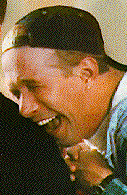 |
Lara Flynn Boyle, Josh Charles and Stephen Baldwin in "Threesome" (1994) |
Threesome, (1994) a film directed by Andrew Fleming. Released by TriStar Pictures, it showcased at the 1994 Sundance Festival and then went into short-lived commercial release to mostly negative reviews. (Janet Maslin of the New York Times claimed it had a narrow emotional range and annoyingly "hip" pretensions.) Nonetheless, it is one of the first Hollywood films to portray gay and bisexual themes and the search for sexual identity in a way that avoided both negative and pollyanish stereotypes.
 |
"Northern Exposure" (1994) |
In the May 9, 1994 episode of the television show "Northern Exposure," Ron Rance and Erick Hillman, two recurring gay characters who run a bed-and-breakfast in fictional Cicely, Alaska, and who just happen to be ex-marines, got married. According to Andrew Schneider, one of the show's producers, "It's just another wedding. The point of the episode is that this is not about gay people getting married; it's about how two people relate." (Quoted in The Advocate, April 19, 1994.) The actors are Doug Ballard and Don McManus.
